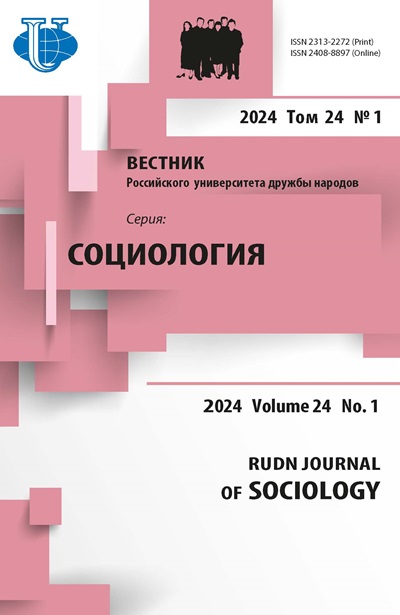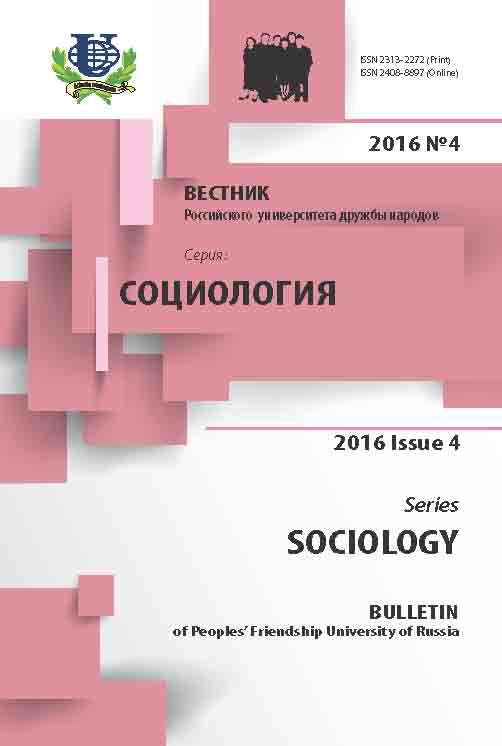“Subjective” and “objective’ insincerity in sociological surveys: Nonverbal manifestations
- Authors: Puzanova Z.V1, Larina TI1
-
Affiliations:
- Peoples’ Friendship University of Russia
- Issue: Vol 16, No 4 (2016)
- Pages: 859-869
- Section: Sociological lectures
- URL: https://journals.rudn.ru/sociology/article/view/14817
Cite item
Full Text
Abstract
Insincerity of respondents in sociological research is a challenge affecting both quality of the sociological tool and the quality of the data obtained, especially features of the psychological interaction. Insincerity is information which respondents distort intentionally. However, there are two types of such insincerity - ‘objective’, i.e. a protective strategy used to deliberately hide some information, and ‘subjective’, when a respondent is forced to provide irrelevant information due to misunderstanding the question or incompetence. Nonverbal manifestations inform of thoughts and sometimes motives of respondents’ answers. In the example given in the article the ‘objective’ insincerity prevails due to the sensitive topic, while in other types of similar surveys the ‘subjective’ insincerity usually takes place too. Insincerity is not an emotion, rather a complex of cognitive attitudes and processes in a form of respond to a stimuli, but insincerity is accompanied by emotions which are the main differentiating signs of types of insincerity. Using the technology for the analysis of respondents’ nonverbal reactions in sociological research, we can identify the type of insincerity. The authors provide examples of certain emotions as reactions to specific provocative questions under the experiment and make a conclusion about the possibilities to identify not only incorrect or ‘threatening’ questions, but also the types of insincerity when answering such questions.
About the authors
Zh V Puzanova
Peoples’ Friendship University of Russia
Author for correspondence.
Email: puzanovz_zhv@rudn.university
Moscow, Russia
T I Larina
Peoples’ Friendship University of Russia
Email: larina_ti@rudn.university
Moscow, Russia
References
- Aver'yanov L.Ya. Iskusstvo zadavat' voprosy: Zametki sociologa [The Art of Asking Ques-tions: Notes of the Sociologist]. M.: Moskovskij rabochij, 1987.
- Davydov A.A., Davydova E.V. Izmerenie iskrennosti respondent [How to Measure Respond-ents’ Sincerity]. M.: IS RAN, 1992.
- Devyatko I.F. Metody sociologicheskogo issledovaniya [Methods of Sociological Research]. Ekaterinburg: Izd-vo Ural'skogo universiteta, 1998.
- Izard K.E. Psihologiya emocij [Psychology of Emotions]. SPb.: Piter, 2011.
- Myers D. Social'naya psihologiya [Social Psychology]. SPb.: Prajm-Evroznak, 2002.
- Mezhkul'turnoe vzaimodejstvie v poliehtnichnoj molodezhnoj srede: sociologicheskij podhod [Intercultural Interaction Among the Multiethnic Youth: Sociological Approach]. Pod red. N.P. Narbuta, D.G. Podvojskogo. M.: Ekon-inform, 2012.
- Myagkov A.Yu. Iskrennost' respondentov v massovyh oprosah [Sincerity of Respondents in Mass Surveys]: Dis. d.s.n. Ivanovo, 2003.
- Myagkov A.Yu. Iskrennost' respondentov: konceptual'nyj analiz [Sincerity of Respondents: Conceptual Analysis]. Vestnik Tambovskogo universiteta. Seriya “Gumanitarnye nauki”. 2004. No. 3. Pp. 22-29.
- Pilkington H., Omel'chenko E. «Zachem mne vrat'?» Opyt primeneniya interv'yu k izucheniyu russkoyazychnoj migracii [“Why would I lie?” The use of interview to study the Russian-speaking migration]. Rubezh. 1997. No. 10-11.
- Posobie po primeneniyu MMPI [Manual for MMPI Application]. Sost. A.A. Rukavishnikov, N.G. Rukavishnikova, M.B. Sokolova. Yaroslavl': NPC «Psihodiagnostika», 1993.
- Puzanova Zh.V., Larina T.I. Ispolzovanie sistemyi kodirovaniya affektov (SPAFF) v fokus-gruppovyih issledovaniyah [Using the Specific Affect Coding System (SPAFF) in focus group research]. Zhurnal sotsiologii i sotsialnoy antropologii. 2016. Vol. XIX. No. 4.
- Fraj O. Lozh'. Tri sposoba vyyavleniya. Kak chitat' mysli lzheca, kak obmanut' detektor lzhi [False: Three Methods of Detection. How to Read the Mind of a Liar, How to Cheat the Lie Detector]. SPb.: Prajm-EVROZNAK, 2006.
- Shibutani T. Social'naya psihologiya [Social Psychology]. Per. s angl. V.B. Ol'shanskogo. Ros-tov n/D: “Feniks”, 2002.














